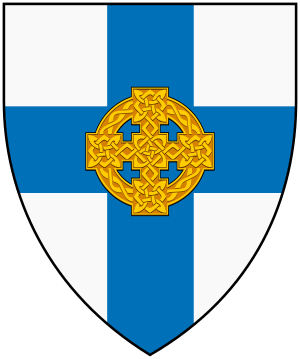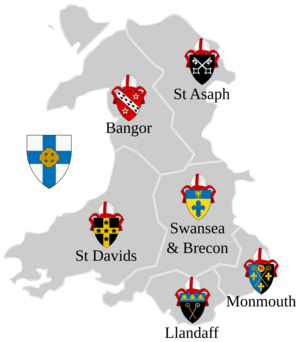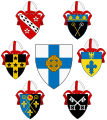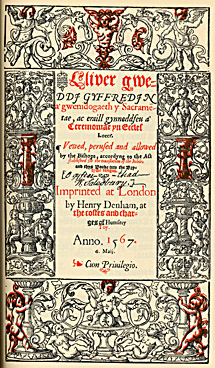Church in Wales facts for kids
Quick facts for kids Church in WalesYr Eglwys yng Nghymru |
|
|---|---|

Coat of arms of the Church in Wales
|
|
| Type | Communion |
| Classification | Protestant |
| Orientation | Anglican |
| Scripture | Bible |
| Theology | Anglican doctrine |
| Polity | Episcopal |
| Primate | Andy John, Archbishop of Wales and Bishop of Bangor |
| Language | Welsh and English |
| Headquarters | Cardiff |
| Territory | Wales with 1,500 congregations |
| Independence | 1920 (disestablishment) |
| Members | 42,441 (2018) |
The Church in Wales (Welsh: Yr Eglwys yng Nghymru) is an Anglican church in Wales. It is made up of six main areas called dioceses.
The leader of the Church in Wales is the Archbishop of Wales. This person also serves as a bishop for one of the six dioceses. Currently, Andy John, who is the Bishop of Bangor, holds this important role since 2021.
Unlike the Church of England, the Church in Wales is not a "state church." This means it is separate from the government. This separation happened in 1920.
The Church in Wales is part of a worldwide family of churches called the Anglican Communion. It looks to the Archbishop of Canterbury as a spiritual leader, but he does not have direct power over the Church in Wales.
Contents
What is the Church in Wales's official name?
The Church in Wales (Welsh: Yr Eglwys yng Nghymru) got its name by chance. A law from 1914 called it "the Church in Wales." This phrase was used to describe the part of the Church of England that was located in Wales.
Legal experts suggested keeping this name to match the law. So, even though some people preferred "the Church of Wales," the name "the Church in Wales" was chosen.
How did the Church in Wales begin?
Christianity in Wales has a very long history, going back to Roman times. An organized church with bishops has been in Wales ever since. In the 6th and 7th centuries, many important religious leaders like Saint David started churches and monasteries across the country.
During this time, Welsh people developed a strong shared identity. This identity came from their language and their Christian beliefs. For many centuries, the Welsh churches were part of the wider Christian church in Europe.
When did the Church in Wales become independent?
By the 1800s, many other Protestant churches in Wales grew very quickly. These were called Nonconformist churches. They became very popular, and many Welsh Christians joined them.
For a long time, no Welsh-speaking bishops were appointed to lead the church in Wales. This caused a lot of unhappiness among Welsh people. They saw separating the church from the state as a way to show their national identity.
Influential Welsh politicians, like David Lloyd George, worked to separate the Anglican church in Wales from the Church of England. This process is called disestablishment. A law was passed in 1914 to make this happen.
The law was strongly opposed by some politicians. However, it eventually passed. This meant the Church in Wales lost its special legal status. Welsh bishops could no longer sit in the House of Lords in the British Parliament.
The church also lost some of its old funding sources. This was called disendowment. However, the Church in Wales kept all its historic church buildings. It also kept the right to perform legal marriages.
Because of World War I, the separation did not happen right away. It finally came into effect in 1920. The Church in Wales then created its own rules and set up a Governing Body to make decisions.
What is the Church in Wales like today?
Today, the Church in Wales is completely independent. It is not controlled by the government or the Church of England. It is a full member of the Anglican Communion.
In recent years, the Church in Wales has discussed important topics. These include allowing women to become bishops. They also discuss making sure both Welsh and English languages are equally important in church life.
How many people are members?
After becoming independent in 1920, the Church in Wales did better than some other churches for a while. In 1960, it had over 180,000 members who took communion.
In 2018, about 42,441 people were officially on the church's membership list. The church reports that over 200,000 people attend its services each year, including special events like Christmas carol services. The Anglican church says it is the largest Christian group in Wales.
How is the Church in Wales organized?
The Church in Wales is organized with bishops, just like other Anglican churches. This is called episcopal church governance.
Before 1920, there were four main areas, or dioceses, in Wales. Each was led by a bishop:
- The Diocese of Bangor
- The Diocese of St Asaph
- The Diocese of St Davids
- The Diocese of Llandaff
Soon after the Church in Wales became independent, two more dioceses were created:
- The Diocese of Monmouth in 1921
- The Diocese of Swansea and Brecon in 1923
Each diocese is divided into smaller areas called archdeaconries. These are led by archdeacons who help the bishop manage the area. Archdeaconries are then divided into even smaller areas called deaneries.
Every diocese has its own cathedral. This is the main church of the diocese and where the bishop's special chair (called a 'cathedra') is located. Important events like the start of a new bishop's time in office happen here. Each cathedral has a dean who manages it.
What are the diocesan coats of arms?
Each diocese and bishop has a special symbol called a coat of arms. These symbols represent their history and identity.
Who is the Archbishop?
Since 1920, the Church in Wales has been led by the Archbishop of Wales. This archbishop is chosen from the bishops who are already serving. They continue to be a bishop of their own diocese while also being the archbishop.
A famous former Archbishop of Wales, Rowan Williams, later became the Archbishop of Canterbury. He was the first Welsh-born person to hold that position.
Who are the diocesan bishops?
Bishops in the Church in Wales are chosen by a special group called an "electoral college." This group includes all the bishops, plus church members (both clergy and regular people) from all the dioceses.
In 2013, the Church in Wales decided to allow women to become bishops. In 2016, Joanna Penberthy became the first woman bishop in the church. As of 2022, most of the active bishops in the Church in Wales are women.
The current bishops are:
- Andy John, Bishop of Bangor and Archbishop of Wales
- Gregory Cameron, Bishop of St Asaph
- Cherry Vann, Bishop of Monmouth
- John Lomas, Bishop of Swansea and Brecon
- Mary Stallard, Bishop of Llandaff
- Dorrien Davies, Bishop of St Davids
What is the Representative Body?
The Representative Body of the Church in Wales manages the church's property and money. It helps pay for clergy salaries and pensions. This body was set up after the church became independent to hold its assets.
What is the Governing Body?
The Governing Body is like the parliament of the Church in Wales. It makes important decisions about the church's beliefs, rules, and worship. It also sets regulations for managing the church's affairs. This body usually meets twice a year.
How does the Church in Wales worship?
The Church in Wales often has traditional worship styles. These traditions come from a movement in the 1800s that focused on older church practices. However, there are also churches that have more modern, evangelical worship styles, especially in southern Wales.
What is the Book of Common Prayer?
In 1563, a law ordered that the Bible and the Book of Common Prayer be translated into Welsh. The first Welsh prayer book was published in 1567.
The Book of Common Prayer contains the words and prayers used for church services. The Church in Wales has updated its prayer books over the years. This includes versions in both traditional and modern English.
What does the Church in Wales believe?
The main teaching of the Church in Wales is about the life, death, and resurrection of Jesus Christ. Here are some core beliefs:
- Jesus Christ is both fully human and fully God. He died and came back to life.
- Believing in Jesus offers a path to eternal life.
- The Old and New Testaments of the Bible were written with God's inspiration.
- The two most important church ceremonies are Holy Baptism and Holy Eucharist (also called Holy Communion).
- Other special church ceremonies include confirmation, holy orders (becoming a priest or deacon), matrimony (marriage), and anointing of the sick.
- Christians believe in heaven, hell, and that Jesus will return one day.
The Church in Wales uses the Bible, church traditions, and human reason to understand its faith. The Bible is the main source of teaching. If something is not clear in the Bible, tradition and reason help guide understanding.
Can women be ordained?
The Church in Wales has allowed women to serve as deacons since 1884. In 1996, the church voted to allow women to become priests. Women have served as priests since 1997.
In 2013, the church voted to allow women to become bishops. In 2016, Joanna Penberthy became the first woman bishop in the Church in Wales. By 2020, there were three women bishops and three men bishops.
What about modern issues?
Since the 1980s, the Church in Wales has openly discussed many modern issues. These include social fairness and welcoming all people.
In 2005, the church allowed clergy in civil partnerships to serve. In 2021, the Church in Wales voted to formally bless couples in civil partnerships. This shows the church's commitment to being welcoming and inclusive.
How does the Church in Wales work with other churches?
The Church in Wales works closely with other Christian churches. It is a member of the Porvoo Communion, which connects it with other Anglican and Lutheran churches in Europe.
It also works with other churches in Wales through groups like the Covenanted Churches in Wales. In 1982, the Church in Wales signed an agreement with Methodist, Presbyterian, United Reformed, and some Baptist churches. This agreement, called Enfys (meaning "rainbow"), aims for greater unity among churches.
See also
 In Spanish: Iglesia de Gales para niños
In Spanish: Iglesia de Gales para niños
- Cytûn – Churches Together in Wales
- List of archdeacons in the Church in Wales
- List of Church in Wales churches
- Religion in Wales
Images for kids
-
F. E. Smith opposed the church's separation from the state.












